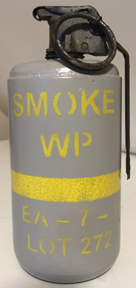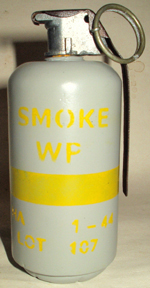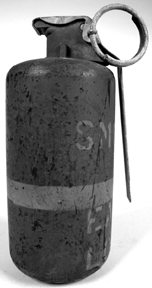|
Type- Smoke
Weight- 32 oz.
Length- 5 in. total
Diameter- 2.38 in.
Filling- 15 oz. WP
Igniter- M6A2, M6A3, M6A4D,
M206A1, M206A2
Fuze Delay- 4-5 sec.
The M15 grenade was adopted as
standard on 24 November 1942 and was used for many years after.
During the Korean War reports surfaced that the M15 was producing
unsatisfactory results, when the grenade impacted in water filled rice
paddies the effects of the WP were nullified.
An alternative method was required immediately.
The M15 was adapted to fit the
Adapter, Grenade Projection, Chemical, T2E1 by means of a locally
manufactured adapter. The
adapter was made by cutting off M7 grenade cans to a length of 2.5
inches and forcing them over the bottom of the M15 grenade.
The modified grenade could then be attached to the T2E1 adapter
and fired from a rifle to obtain airbursts.
The deficiencies resulted in a project to develop a replacement
that could also be fired from a rifle.
The M15 was redesignated as substitute standard on 30 April 1959
when the M34 was adopted as standard.
It appears that in
WWII there were at least three body styles.
The first is made of 18 gauge steel in a cylindrical shape.
The bottom body is formed in one piece.
The top is heavier and welded to the bottom to form an airtight
body. The top has a
threaded hole in the centre to accept the detonator well which acts as a
seal after filling. The
igniter mechanism screws into the detonator well.
This appears to be the most common body type.
The second body type has the top formed in one piece with the
bottom welded into the top section.
This type has the base divided into six pie shaped sections by
grooves. A bushing is
screwed and welded into a hole in the top of the body to accept the
detonator well and seal the body.
The igniter mechanism screws into the detonator well.
A final body type is made in one piece and has a bushing welded
into the top to accept the detonator well and has a large filling hole
in the bottom closed by a large plug. The
body is filled with 15 ounces of white phosphorous.
The fuze mechanism has changed a number of times over the life of
the grenade.
The body is painted
grey with a yellow band around the body.
The body is marked above the band with “SMOKE WP” and below the
band with the lot number and date of manufacture.
Later manufactured grenades are marked above the band with “SMOKE
WP BURSTING TYPE”.
All markings are in yellow.
When the grenade is
thrown and the fuze functions, after a delay of 4-5 seconds the
detonator bursts the body scattering the WP over an area of about 15
yards. The WP ignites upon
contact with the air forming a dense cloud of white smoke.
It also has a very effective anti-personnel effect.
|


